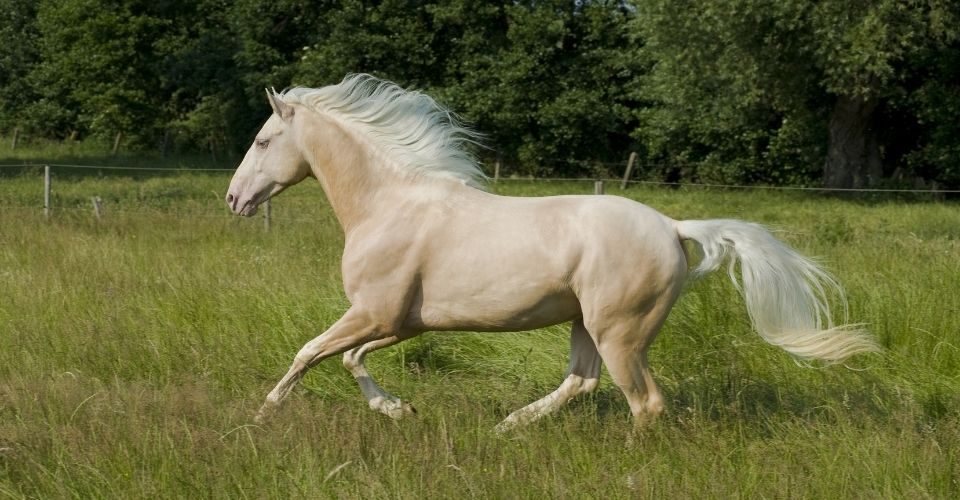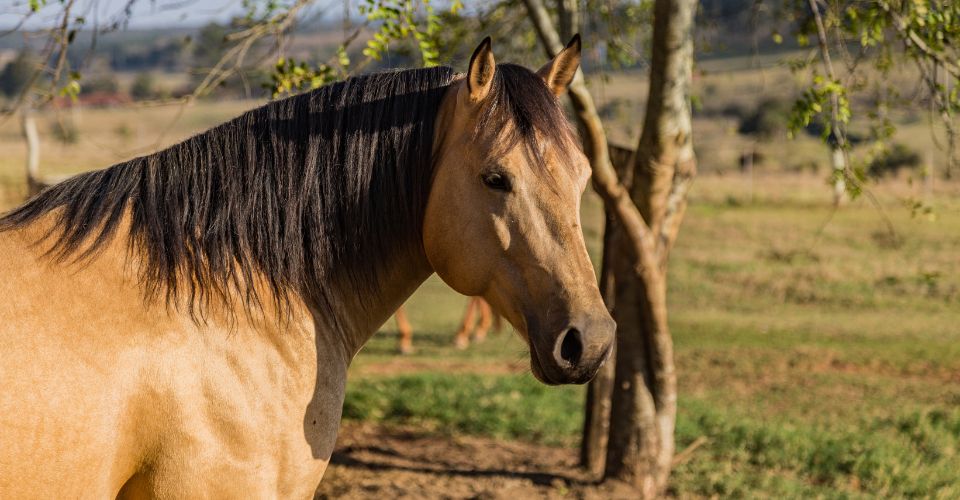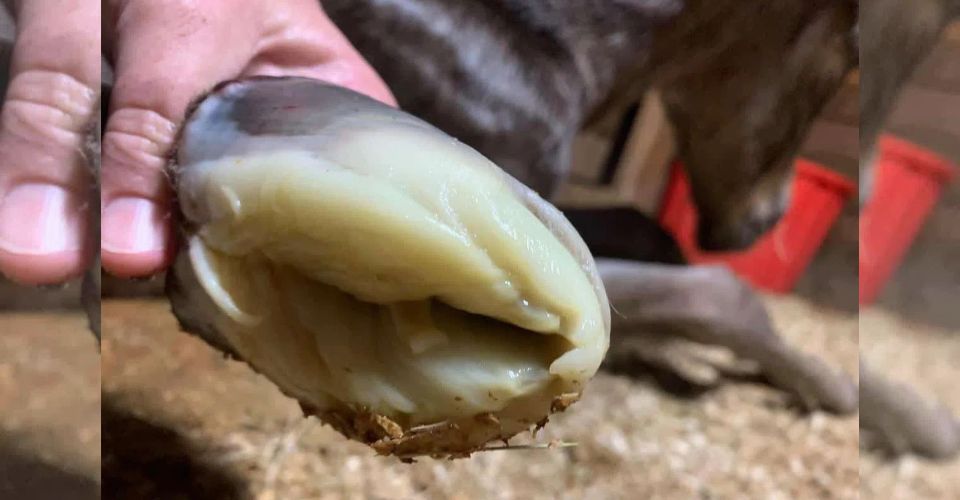If heaven had an army of horses, they’d definitely be Cremellos, looking as if they just galloped right out of a fairytale. Cream color, white mane, pink skin, blue eyes, and looks like a fantasy. They’re a masterpiece!
Cremellos are usually found in Shetland ponies, Quarter Horses, Saddlebreds, and draft horses. On a chestnut base color, it creates the Palomino; while on a bay base, it produces Perlino or buckskin. The effect of the cream gene is to lighten the eye, skin, and coat.
When one copy of the gene takes place, it acts as a dilution gene, lightening red to gold or yellow, especially on the tail and mane. When two copies of the gene occur, black hair turns reddish while red hair becomes cream. A single copy has a minute influence on the eye color, whereas two copies make the eyes blue and the skin turns rosy pink.
Cremellos are registered by the Cremello and Perlino Educational Association (CPEA) and the American White & American Crème Horse Registry.
This article will further detail all you need to know about the Cremello horses. Hop on!
Facts About Cremello Horse
Some important details you need to know about this rare horse are as under:
It’s Not a Breed
Many people identify Cremello as a breed but it is, in fact, a color and it can be found in any breed. So, it is wrong to call it a white color breed. The true white color breeds are Connemara, Camargue, Lipizzan, Boulonnais, and Shagya Arabian.
Cremello is just a work of genetics, the color resulting from the color genetics of the dam and sire. The base color of a Cremello is actually red or chestnut.
The distinctive color is due to two cream dilution genes on a chestnut horse (double diluted). Genetics and basic colors are the deciding factors. Cremellos have two cream dilution genes, resulting in a double dilution. When two Palominos are bred together, the foal has a 25% chance of inheriting both cream genes, giving it a Cremello color!
Cremello Horse Is Identified From Mane and Tail
Cremello and Palominos have creamy white coats, blue eyes, and rose pink skin that are nearly similar. The mane and tail are the sole features that distinguish them. The mane and tail of a Cremello horse are generally as creamy as the rest of the body, but the mane and tail of a Palominos horse are a touch darker in color.
Cremello Look Similar to Albino Horses
Cremello horses are frequently compared to Palominos because they appear to be identical, however, Cremello horses are more close to Albino horses. The only visual difference between the two is that Cremello horses are creamier, while Albino horses are more white. Albino horses are born white and have no pigment.
Cremello Horses Have No Markings
The Cremello horse’s coat is evenly creamy with no markings. Their lack of markings adds more to their uniqueness.
Cremello Horses Do Not Carry Any Specific Genetic Issues
The majority of horse enthusiasts link Cremello horses with eye, blood clotting, and hearing issues. Cremello horses, in reality, have no such genetic flaws or abnormalities.
Wondering how this major misunderstanding came to be? It’s because Palominos (that are quite similar to Cremello horses) have been known to suffer such genetic problems. The horse enthusiasts who fail to recognize that the problems are with Palominos and not Cremello, is the “real” cause of this misunderstanding.
Cremello Horses Do Not Change Their Coat Color
Cremello horses, unlike grey horses, are born creamy and stay that way all their life. Other lighter-colored horses are usually born darker and gradually lighten their coat color until it reaches the lightest tint that may be considered white. Cremello horses are an anomaly in that they maintain their color throughout their lives.
Two Palominos Crossing Can Produce a Cremello Horse
Yes, you read that right. A Cremello foal can be produced by two Palomino horses, although the chance of attaining the color is just 25%. Cremello foals, produced by the mating of two Palominos, are blue-eyed, completely creamy white, and have no markings.
Cremello Horse’s Eye Color Changes Over Time
The Cremello horses’ eyes do change color, but not to the point where it is visible. Cremello foals are born with darker eyes, but as they get older, their eyes lighten until they seem creamy.
Cremello Is Bred Only for Its Color
Except for the beautiful white and creamy colors, neither Cremello nor Palomino has any distinguishing features. So they were and still are being bred primarily to produce creamy (Cremello) and white (Palomino) horses.
History of Cremello Horse
It’s hard to determine when Cremello horses first appeared; it was probably a long time ago when the concept of preserving history hadn’t occurred to equine historians or breeders.
What a pity that history books are mute and skeptical about these magnificent horses! To add insult to injury, Cremello horses are extremely rare, so uncovering the truth behind the myths is difficult. Cremello, however, is clearly the result of cream gene breeding.
Behavior and Temperament of Cremello Horses
Some people believe that blue-eyed horses act more ferociously. A horse’s appearance has no influence on its temperament or personality. What counts most is the horse’s breed and genetics.
If you have a Quarter Horse, you may expect an animal that is eager to please you while still being laid-back. An Arabian, on the other hand, cannot be spoken in the same way. A horse that comes from a lineage of aggressive horses is unlikely to be gentle. This variety may be found in the temperaments of several Cremello horse breeds.
Appearance & Varieties
Cremellos, Albinos, and Perlinos may appear the same to an untrained eye, but once you know what to look for, you’ll see the differences.
Cremello has an unspotted cream-colored coat, a white mane and tail, a distinct pink skin beneath its cream coat, blue eyes, and a pink nose. So, how do you differentiate between Cremellos, Albinos, and Perlinos? Albinos also have blue eyes, pink noses, white manes, and tails, but lack the cream shade on their coat; they are pure white. You might not be able to identify that from a distance, which is why Albinos and Cremellos are often mistaken.
Perlinos, however, have the same cream-colored coat as Cremellos, the same pink skin, and blue eyes, but their mane and tail have a distinct reddish hue to them, whereas the tail and mane of Cremello are always white.
Cremellos not only have an impressive creamy color, but they are compact, skinny, and super attractive too. Moreover, Cremello horse can be recognized by its expressive face, well-defined withers, laid-back shoulders, arched neck, and strong limbs.
How to Take Care of a Cremello Horse
Among all animals, horses require the most care, time, and financial commitment. They must be provided with the right diet or pasture and have proper housing to protect them from predators and harsh weather. Scheduled vet visits are also a must to keep the horse healthy.
Cremellos horses require even more attention because of their light coat. If they are exposed to strong sunlight, they’ll have sunburns and other skin problems. Hence, it is mandatory to build them stables with proper roofing to avoid the sun. You can even use horse sunscreen and UV blocking masks during the hot summers.
Do Cremello Horses Have Skin Problems or Health Issues?
Do Cremello horses sunburn quickly or have chances of cancer due to pink skin? It’s not the case because there is a distinction between pinks. There is no such scientific research on this, but Cremello horse owners say that their horses (double dilutes) sunburn just like any other horse. However, they do fine with sunblock on.
Other than sunburn, Cremello horses face the same health issues that other horses normally do, such as Arthritis, Laminitis, Colic, Desmitis, Gastric Ulcers, and Back pain, to name a few.
Do Cremello Horses Get Along With Other Horses?
Since Cremello Horses is not a breed, therefore, the way they behave towards other horses depends on individual temperament and other factors peculiar to an individual horse. Generally, horses tolerate each other but may require some time to form the pecking order.
Fights can be expected sometimes, and some confrontations might result in injuries too. Therefore, it is vital to keep an eye on your stable after bringing in a new horse to their home. The best way to introduce horses to each other is across the fence.
What to Feed Your Cremello Horse
Just like any other horse, a Cremello’s diet should also consist mainly of pasture and good quality hay because their digestive systems are designed to eat roughage, which typically comes from grassy stalks. Experts recommend ensuring that your horse eats around 1-2% of its body weight in roughage daily.
Also, avoid feeding your Cremello right after or before exercise because the digestive process requires a lot of blood and oxygen for a smoother operation. On the other hand, exercise diverts blood from the digestive organs, showing gut action. Hence, riding a full horse puts them at risk of colic.
Allow them to cool down completely after work before you feed them, wait for their heart rate to go back to normal. Moreover, ensure that your horse’s skin does not feel sweaty or sticky.
One of the foremost things to ensure is that your horse has access to fresh, clean water at all times.
Breeding a Cremello Horse
Cremellos come from selecting traits that make a horse’s coat appear lighter through a process called color dilution. Breeds such as Palomino or buckskin that have cream genes are used to achieve the Cremello color.
However, Cremellos are double diluted, which means they have two copies of the cream gene. Many horses with cream genes only have a single copy, so the idea is to cross such breeds with others, hoping that one of their foals shall be double diluted. The chances of that occurring are, however, around 25%.
The most common breeds for creating Cremellos are Saddlebreds, Draft horses, Shetland, Ponies, and Quarter Horses because they all are “chestnuts” with a cream gene. Using “bays” with a cream gene is more likely to result in a Perlino.
Keeping Your Cremello Horse Healthy
Along with a proper diet, Cremello horses need access to the following to stay healthy.
Regular Deworming and Vaccinations
Worms are notorious for causing colic, weight loss, as well as decreasing the quality of your horse’s coat. That’s why deworming and vaccinating your Cremello regularly is important for it to remain in good condition. The ideal vaccines for your horse depend on certain factors, such as activity levels, age, and location. Hence, consult your vet to decide what is best for your horse.
Also, make use of proper management practices to reduce your horse’s contact with parasites. It might include rotating pastures on a regular basis, removing manure, and not overcrowding its room.
Proper Housing, Exercise, and Rest
Proper housing is required to protect your Cremello from adverse weather conditions as well as giving them a place to sleep and rest. A stall is a good option, but not all horses are comfortable in a three-sided shelter.
If your Cremello is stalled, make sure to exercise them daily. It’ll help prevent physiological and behavioral problems.
Hoof and Teeth Care
Experts recommend trimming your horse’s hooves every 6-8 weeks. Depending on your Cremello’s activity levels, body type, and environment, they might require shoes too. You may consider reading why do horses need shoes if you are not sure if your horse needs them. Talk to the farrier about the most suitable way to keep your horse’s hooves in good condition.
Horses are also predisposed to dental problems because their teeth never stop growing, which is another reason why their diet should consist of roughage, as it helps to file them. Without good care, a Cremello’s teeth can wear unevenly, forming sharp edges and points that make chewing painful and difficult.
This can cause weight loss, colic, and esophageal blockage (choking). Traces of dental problems in equines include foul breath, rotting teeth, and undigested hay in the stool. Make sure to get your Cremello’s teeth checked by a vet at least twice a year to avoid possible dental problems.
Lifespan
The average lifespan of the Cremello horse is up to 30 years. Some exceptionally well-raised Cremello horses have been recorded to live up to 40 years as well, but not all well-raised make it to 40.
Are Cremello Horses Right for You?
If you’re in search of a show animal or a horse that will turn heads, then you can surely go for a Cremello horse, but make sure that you have the required resources to keep your horse happy and content.
How Much Do Cremello Horses Cost?
Cremello horses are rare and in demand, so as expected, you have to pay more for them than a regular horse. However, the true cost of a Cremello is determined by the particular breed. For example, Lusitano Mare could cost $20,000 while a Quarter Horse filly could go for as little as $2,700.
Other factors like pedigree, conformation, or height also affect the price of a Cremello horse. Make sure to buy from a reputable breeder to ensure you get a healthy Cremello horse.





